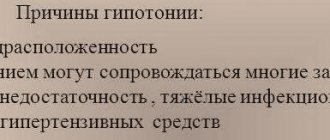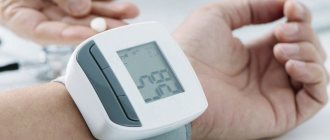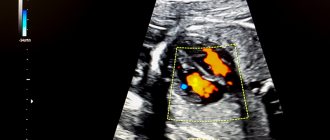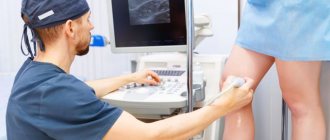Headache, dizziness, decreased visual acuity, nosebleeds, vomiting, sleep disturbances, short-term fainting - all this can be signs of high blood pressure in a child. The prevalence of arterial hypertension (AH) in children and adolescents is currently second only to asthma and obesity among chronic childhood diseases! A number of studies indicate that almost every 5 child in our country is susceptible to hypertension...
How to suspect high blood pressure (BP) in a child? In addition to those listed above, this is to learn how to correctly measure a child’s blood pressure. This is done a little more difficult than for an adult. Of course, the doctor will do this faster and more accurately, but you can also learn how to measure blood pressure at home.
HOW TO CORRECTLY MEASURE A CHILD'S BP?
1. First, understand what pressure will be normal for your child. To do this, you need to use three percentile tables (tables of percentages of different values):
- In Table 1, find your child’s age and height (for boys and girls, these are different parts of the table) and remember your child’s “height percentile” (from 5% to 95%).
- In Table 2 (for boys) or in Table 3 (for girls) look for the child’s age, correlate it with the “height percentile” and then find the value for the upper (systolic) and lower (diastolic) pressure. The optimal value will be up to 90%. Above is already above the norm.
2. In order to measure blood pressure, you need a tonometer, but most importantly, the correct - children's - cuff. For electronic tonometers there is only one children's cuff (diameter 15-22 cm). For mechanical ones, the diameter of the cuff for children starts from 7 cm. The size of the cuff corresponds to the circumference of the arm at the place where it is applied (measured with a measuring tape).
3. Measure blood pressure in your arms three times with an interval of 2-3 minutes, and calculate the average value. Compare with recommended.
4. Keep a blood pressure diary. If there was a one-time increase, it is recommended to measure 2-3 times during the day at rest while sitting, as well as in case of characteristic complaints (headaches, nosebleeds, dizziness).
What is low blood pressure and why is it dangerous?
Remember the borderline Low blood pressure (hypotension) level - 90/60. As long as the tonometer shows you these or higher values, everything is fine. But as soon as any of the numbers decreases - be it the first or the second - we can talk about low pressure.
Find out ☝
- How to measure pressure correctly
There is an important nuance here. If everything is clear with high blood pressure: it is categorically dangerous for everyone, then low blood pressure may simply be your peculiarity. As long as it does not spoil life with ailments, it is not considered a violation, and there is no need to fight it.
It’s another matter if the following symptoms appear:
- weakness;
- dizziness, up to a state when it seems that you are about to lose consciousness;
- blurred vision;
- nausea;
- chills;
- sweating;
- decreased concentration.
This complex seriously spoils life and interferes with work and communication. But the most important thing: low blood pressure, if it is accompanied by unpleasant symptoms, is in fact also just a symptom.
The causes of low blood pressure can be very different: from simple dehydration and stress to hormonal imbalances, internal bleeding and myocardial infarction.
It is important to find out what exactly is causing hypotension and begin treatment. When the underlying disease is defeated, the blood pressure will normalize on its own.
WHEN does a child need to have their blood pressure measured?
In accordance with the order of the Ministry of Health of the Russian Federation dated July 3, 2000 No. 241, blood pressure should be measured at the age of 3 years (before entering a nursery school, kindergarten), 1 year before school (at 5-6 years), immediately before school (6 -7 years), after finishing 1st grade (7-8 years), at the ages of 10, 12, 14-15, 16 and 17 years.
- In children under 1 year of age, this pathology is most often associated with concomitant diseases - pathology of the kidneys, endocrine system, as well as congenital heart disease (coarctation of the aorta).
- From one to 6 years of age, pathologies of the kidneys and endocrine system are also the leading causes. Such children are observed by specialists and should be additionally examined by a cardiologist.
- From the age of 7, cases of so-called essential hypertension (primary, for unknown reasons) are detected.
- During puberty, this type of hypertension becomes the leading one.
How to permanently increase blood pressure without medications
We repeat: with the help of a doctor who will determine the causes of your condition and prescribe a treatment regimen. To relieve symptoms, your doctor will prescribe medications that return low blood pressure to normal.
However, you can help your body by making a few lifestyle changes. Here's what doctors advise Low Blood Pressure (Orthostatic Hypotension) to do for hypotension:
- Drink more water, especially if it's hot outside or you have a fever.
- Limit your alcohol intake. If possible, give up alcohol altogether.
- Exercise regularly or at least walk more: physical activity improves vascular tone.
- Try not to stand in one place for a long time. If you have a standing job, warm up more often: walk. squat, jump, dance.
- Do not take long hot baths. A healthier option is a contrast shower.
- Reduce the amount of carbohydrates in your diet. If you want something sweet, eat fruit.
WHAT TO DO IF A CHILD HAS HIGH BP?
If this was discovered during an examination by a doctor, then keep in mind that children have so-called “white coat” hypertension due to the child’s emotional lability. If this turns out to be not an isolated case, then you should definitely keep a diary where you can record the child’s blood pressure readings. Moreover, it is necessary to measure at the same time. It is also additionally necessary to conduct examinations to assess damage to other organs (the so-called target organs): clinical blood test, clinical urine test, biochemical blood test with assessment of the lipid spectrum, electrolytes, glucose and renal markers, ECG, echocardiography, fundus examination , Ultrasound of the kidneys with assessment of blood vessels, 24-hour blood pressure monitoring.
Based on the results of the examination, treatment is prescribed with recommendations for control and lifestyle. In short, if a child has high blood pressure, it is recommended that he:
- first of all, normalization of lifestyle,
- healthy 8-10 hour sleep, regular physical activity in the form of walking, running, swimming, skating, skiing, cycling 30-60 minutes a day, limiting weight lifting (static loads),
- limiting work on gadgets to 30-40 minutes a day,
- proper nutrition (limiting table salt, reducing light carbohydrates),
- normalization of weight in case of excess.
If a hypertensive crisis occurs with a worsening condition, call an ambulance; it is not recommended to take medications on your own if they have not previously been selected by a doctor; incorrect dosage selection can worsen the condition!
How to quickly increase blood pressure at home
Let us remind you: if low blood pressure has unpleasant symptoms, go to a therapist. Otherwise, you risk missing a possible hidden and much more global illness. But until you see a doctor or a specialist has not yet determined the cause of the ailment, you can use simple home remedies to increase your blood pressure. Choose the one that is most comfortable for you or combine them.
Eat something salty
A piece of herring, a pickled cucumber, a couple of slices of feta cheese or other pickled cheese, a spoonful of rice generously seasoned with soy sauce...
Sodium chloride (the same table salt) increases Low blood pressure (hypotension). Sometimes sharply, so salt is strictly contraindicated for people suffering from hypertension. But here we have the opposite case.
Attention! You can’t constantly increase your blood pressure with salty foods. Excess sodium can lead to heart failure, especially in older adults.
Drink a glass of water
Or better yet, two if it fits. The liquid will increase blood volume (as a result, its pressure on the walls of blood vessels), and also eliminate possible dehydration.
Wear compression socks or stockings
Elastic stockings are commonly used to reduce swelling and pain in varicose veins. But in addition, they reduce the volume of blood in the legs. The displaced blood will increase the pressure in the main vessels of the body.
Take the correct posture
This is a unique alternative to compression stockings.
If you are sitting, cross your legs. This way you will reduce the blood volume in the lower extremities and increase Nine ways to raise blood pressure pressure in the main vessels. By the way, this is why this pose is contraindicated for people suffering from hypertension.
If you're standing, you can cross your thighs like scissors and squeeze them tightly. The effect will be about the same.
Another option: place one foot on a chair or bench in front of you and lean your whole body forward as deeply as possible.
Have some coffee
This is one of the most popular methods, but it is not guaranteed to be effective. Caffeine can actually increase blood pressure in people who rarely drink coffee. But if you are a coffee lover, the desired effect will not necessarily occur.
WHAT IS THE DANGEROUS OF HIGH BLOOD PRESSURE IN A CHILD?
Every third child with this disease may develop hypertension in the future. High blood pressure affects both the general condition of the child - fatigue, retarded mental and physical development - and various organs, such as the eyes, kidneys, and heart.
But, I would like to emphasize that in children prevention and treatment are more effective than in adults and a complete cure is possible!
Pediatrician and pediatric cardiologist Ekaterina Aleksandrovna Yakunina.
When to call an ambulance
As soon as you notice not only a significant drop in blood pressure in yourself or a loved one, but also
- cold, clammy and pale skin;
- fast shallow breathing;
- weak and fast pulse;
- confusion.
These are signs of so-called acute arterial hypotension (collapse, shock). This condition is life-threatening. It can lead to hypoxia of the brain and internal organs. Therefore, you should not hesitate to seek medical help.
Drug therapy for hypotension
Therapeutic procedures with medications are carried out as prescribed by a specialist. Blood pressure is increased by:
- aralia, lemongrass, immortelle, prickly tartar, eleutherococcus, ginseng, hawthorn, rose radiola - in the form of pharmaceutical tinctures;
- nootropics (intended to stabilize the functioning of the central nervous system) - Nootropil, Noofen, Piracetam, Glycine, Pantogam;
- anticholinergics used to suppress the symptoms of vagotonic VSD - Bellaspon, Bellataminal, Belloid;
- neuroprotectors that have a positive effect on brain function - Vinpocetine, Cinnarizine, Actovegin;
- antioxidants – succinic, citric acid, Ubiquinone;
- antidepressants, tranquilizers that relieve the effects of overwork - Grandaxin, Trioxazin;
- caffeine-based drugs that increase blood pressure - Pentalgin, Excedrin, Saridon, Trimol, Citramon.
In therapy, CNS stimulants can be used, which are responsible for activating the tone of blood vessels and NSAIDs, which suppress headaches. Medications should only be taken with the approval of the attending physician.
How to raise the pressure at school so that they let you go
Low blood pressure is a very common phenomenon, and is often not paid attention to, considering it a common ailment.
You should not treat this alarming sign with such carelessness - over time, a simple problem can cause a lot of trouble and require long-term treatment.
To prevent complications, you can use simple remedies, because you could write a huge dissertation on how to raise blood pressure at home quickly and without special medications.
How to raise blood pressure and pulse with simple drinks
The easiest way to influence not only your blood pressure, but also your pulse, is to use drinks that can dilate blood vessels in a short time. The disadvantage of this method is that the effect is short-lived; it can only be used in emergency cases when there are no medications or more effective folk remedies at hand.
Before raising blood pressure and pulse, you should make sure that they do not meet the standards; use a tonometer for this. Only after this can you begin simple and even pleasant treatment.
Coffee comes first in the fight against short-term low blood pressure. This particular feature of treatment should be taken into account - if the patient is addicted to this drink, then the desired effect may not be expected, because the body gets used to the effects of caffeine over time.
How to raise blood pressure at home quickly? To increase blood pressure almost instantly, just drink a cup of a strong invigorating drink. This is enough for the readings on the tonometer to quickly go up. Even if there is no coffee, it doesn’t matter - you can brew concentrated black tea, be sure to add sugar to it. One cup is enough to feel good.
How to raise your blood pressure so you don't have to go to school
A question that always remains relevant for every schoolchild is how to raise blood pressure so as not to go to school? There are no difficulties here either; there are many ways to stay at home, and with the permission of your parents. Adults will certainly be worried by the fact that their beloved child suffers from high blood pressure. The main thing here is not to overdo it, otherwise, instead of school, you can go to the hospital under the strict supervision of your parents.
How to raise blood pressure at home quickly so as not to go to school? Regular table salt will help here. You can simply salt your breakfast thoroughly, although this will not be as effective as the product in its pure form, and it is quite unpleasant to eat too salty porridge or an over-salted omelet.
It will be much more effective to simply take half a teaspoon of kitchen spice and place it on the tip of your tongue. Now all that remains is to wait until it completely melts and you can safely go to measure the pressure - it will increase significantly. The main thing here is not to hesitate, the effect lasts only a few minutes, but they are enough to convince parents of the need to stay at home.
How to raise blood pressure by pressing special points
There are many ways to quickly raise blood pressure without resorting to food or drinks. This can be done with a special massage, the main thing is to know how to do it correctly.
A massage that will certainly relieve the problem:
- massage the carotid artery in the neck with your fingertips, moving along it from bottom to top for several minutes;
- ask someone from your household to vigorously massage the back of your shoulders;
- Press the palm of your hand several times with force on the very center of the back of the head;
- rub the base of the skull with your thumbs for 1-3 minutes.
Of course, you shouldn’t count on a long-term effect, but often these measures are enough to bring blood pressure back to normal for a short time.
During this time, you can have time to go to the pharmacy for pills or prepare a herbal composition that will help no worse than medications.
You can go to the doctor and get advice on how to raise your blood pressure, if necessary, with simple pharmaceutical medications that do not require a prescription. If you keep them always at hand, troubles with blood pressure will never take you by surprise.
How to quickly normalize blood pressure for an elderly person
Old age often makes itself known not only by wrinkles on the face, but also by low blood pressure. How can an elderly person quickly return their tonometer readings to normal? The first thing that is recommended is to take a shower, and a contrast shower. You can stand under the hot streams of water for a few minutes, then suddenly turn on the cold water.
The next stage of treatment at home is taking tincture of ginseng or echinacea. You can buy them at any pharmacy and keep them nearby at all times, especially if your blood pressure is unstable. You need to take the medicine in small quantities, only 10 ml shortly before meals.
If you don’t have a tincture, you can get by with a simple tea made from Echinacea flowers. Preparation of the drink:
- grind 20 gr. vegetable raw materials;
- boil 220 ml of water;
- pour boiling water over the echinacea flower paste;
- Close the container tightly and wait a quarter of an hour.
You can drink the prepared medicine in one go, but the treatment will be more effective if you divide the liquid into two parts and drink it with a break of half an hour.
How to increase lower pressure quickly
It often happens that the upper pressure is normal, but the lower pressure drops to critical levels. What to do in such cases and how to raise lower pressure quickly without the use of pharmaceutical drugs?
Juice squeezed from aloe leaves will help with this problem. There is one trick in using this wonderful plant - the juice obtained not from fresh, but from slightly withered leaves is considered more useful. You can stock up on medicinal raw materials in advance; to do this, pick a few leaves, wrap them in thin polyethylene and put them in the refrigerator.
Source: https://davleniya.net/davlenie/kak-podnjat-davlenie-v-shkole-chtoby-otpustili.html











